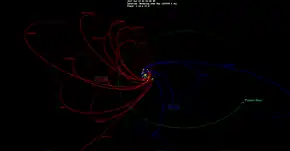 2000 CR105 is seen as a smaller orbit center left in red with hypothetical Planet Nine in green | |
| Discovery[1] | |
|---|---|
| Discovered by | Marc W. Buie |
| Discovery date | 6 February 2000 |
| Designations | |
| 2000 CR105 | |
| Orbital characteristics[2][3] | |
| Epoch 13 January 2016 (JD 2457400.5) | |
| Uncertainty parameter 2 | |
| Observation arc | 5547 days (15.19 yr) |
| Earliest precovery date | 6 February 2000 |
| Aphelion | 411.62 AU (61.577 Tm) (Q) |
| Perihelion | 44.286 AU (6.6251 Tm) (q) |
| 227.95 AU (34.101 Tm) (a) | |
| Eccentricity | 0.80572 (e) |
Average orbital speed | 1.63 km/s |
| 5.28267° (M) | |
| 0° 0m 1.031s / day (n) | |
| Inclination | 22.71773° (i) |
| 128.24627° (Ω) | |
| 317.219° (ω) | |
| Physical characteristics | |
| Dimensions | |
| 0.04 (expected)[5] | |
| Temperature | ~ 19 K |
| 23.8[8] | |
| 6.3[3] | |
(148209) 2000 CR105 is a trans-Neptunian object and the tenth-most-distant known object in the Solar System as of 2015. Considered a detached object,[9][10] it orbits the Sun in a highly eccentric orbit every 3,305 years at an average distance of 222 astronomical units (AU).[3]
Description
Mike Brown's website lists it as a possible dwarf planet with a diameter of 328 kilometres (204 mi) based on an assumed albedo of 0.04 .[5] The albedo is expected to be low because the object has a blue (neutral) color.[5] However, if the albedo is higher, the object could easily be half that size.
(148209) 2000 CR105 and Sedna differ from scattered-disc objects in that they are not within the gravitational influence of the planet Neptune even at their perihelion distances (closest approaches to the Sun). It is something of a mystery as to how these objects came to be in their current, far-flung orbits. Several hypotheses have been put forward:
- They were pulled from their original positions by a passing star.[11][12]
- They were pulled from their original positions by a very distant, and as-yet-undiscovered (albeit unlikely), giant planet.[13]
- They were pulled from their original positions by an undiscovered companion star orbiting the Sun such as Nemesis.[13]
- They were captured from another planetary system during a close encounter early in the Sun's history.[11] According to Kenyon and Bromley, there is a 15% probability that a star like the Sun had an early close encounter and a 1% probability that outer planetary exchanges would have happened. (148209) 2000 CR105 is estimated to be 2–3 times more likely to be a captured planetary object than Sedna.[11]
(148209) 2000 CR105 is the first object discovered in the Solar System to have a semi-major axis exceeding 150 AU, a perihelion beyond Neptune, and an argument of perihelion of 340°±55°.[14] It is one of eleven objects known with a semi-major axis greater than 100 AU and perihelion beyond 42 AU.[15] It may be influenced by Planet Nine.[16]
See also
References
- ↑ "List of numbered minor planets". Center for Astronomy. Harvard University.
- 1 2 Marc W. Buie (21 December 2006). "Orbit Fit and Astrometric record for 148209". SwRI (Space Science Department). Retrieved 18 July 2008.
- 1 2 3 "JPL Small-Body Database Browser: 148209 (2000 CR105)". Retrieved 11 April 2016.
- ↑ "Barycentric Osculating Orbital Elements for 2000 CR105". Retrieved 25 January 2016. (Ephemeris Type:Elements and Center:@0)
- 1 2 3 4 5 Brown, Michael E. "How many dwarf planets are there in the outer solar system? (updates daily)". California Institute of Technology. Archived from the original on 18 October 2011. Retrieved 16 February 2014.
- ↑ "List of known trans-Neptunian objects". Johnston's Archive. Retrieved 5 April 2014.
- 1 2 Hainaut, O.R.; Boehnhardt, H.; Protopapa, S. (October 2012). "Colours of minor bodies in the outer solar system. II. A statistical analysis revisited". Astronomy and Astrophysics. 546: 20. arXiv:1209.1896. Bibcode:2012A&A...546A.115H. doi:10.1051/0004-6361/201219566. S2CID 54776793. Retrieved 26 September 2019.
- ↑ "AstDys (148209) 2000CR105 Ephemerides". Department of Mathematics, University of Pisa, Italy. Archived from the original on 26 May 2011. Retrieved 16 March 2009.
- ↑ Jewitt, David; Morbidelli, Alessandro; Rauer, Heike (2007). Trans-Neptunian Objects and Comets. Swiss Society for Astrophysics and Astronomy. Saas-Fee Advanced Course. Vol. 35. Berlin: Springer. p. 86. ISBN 978-3-540-71957-1.
- ↑ Lykawka, Patryk Sofia; Mukai, Tadashi (July 2007). "Dynamical classification of trans-Neptunian objects: Probing their origin, evolution, and interrelation". Icarus. 189 (1): 213–232. Bibcode:2007Icar..189..213L. doi:10.1016/j.icarus.2007.01.001.
- 1 2 3 Kenyon, Scott J.; Bromley, Benjamin C. (2004). "Stellar encounters as the origin of distant Solar System objects in highly eccentric orbits". Nature. 432 (7017): 598–602. arXiv:astro-ph/0412030. Bibcode:2004Natur.432..598K. doi:10.1038/nature03136. PMID 15577903. S2CID 4427211.
- ↑ Morbidelli, Alessandro; Levison, Harold F. (2004). "Scenarios for the Origin of the Orbits of the Trans-Neptunian Objects 2000 CR105 and 2003 VB12 (Sedna)". The Astronomical Journal. 128 (5): 2564–2576. arXiv:astro-ph/0403358. Bibcode:2004AJ....128.2564M. doi:10.1086/424617. S2CID 119486916.
- 1 2 Matese, John J.; Whitmire, Daniel P.; Lissauer, Jack J. (2005). "A wide-binary solar companion as a possible origin of Sedna-like objects". Earth, Moon, and Planets. 97: 459.
- ↑ "JPL small-body database search engine: a > 150 (AU) and q > 30 (AU)". JPL Solar System Dynamics. Retrieved 9 April 2014.
- ↑ "MPC list of a > 100 and q > 42". IAU Minor Planet Center. Retrieved 24 July 2017.
- ↑ Brown, Mike (12 February 2016). "Why I believe in Planet Nine". FindPlanetNine.com.
External links
- Orbit Determination of 2000 CR105
- Spacecraft escaping the Solar System (Heavens-Above)
- World Book: Worlds Beyond Pluto
- (148209) 2000 CR105 at AstDyS-2, Asteroids—Dynamic Site
- (148209) 2000 CR105 at the JPL Small-Body Database